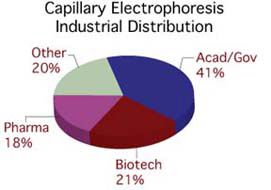Market Profile: Capillary Electrophoresis
Capillary electrophoresis (CE), introduced in the 1980s, utilizes the same principles as gel electrophoresis for the qualitative and quantitative analysis of charged biological molecules, including proteins, carbohydrates, and nucleic acids as well as inorganic compounds.
Capillary electrophoresis (CE), introduced in the 1980s, utilizes the same principles as gel electrophoresis for the qualitative and quantitative analysis of charged biological molecules, including proteins, carbohydrates, and nucleic acids as well as inorganic compounds. CE is very similar relationship to high performance liquid chromatography (HPLC). However, instead of using a pump, CE uses an electromotive force to drive the mobile phase through the capillary tube. The components of a mixture are separated through a horizontal capillary tube made up of fused-silica. When the electric field is applied, the analytes migrate toward the negative electrode, passing through a detector along the way. UV-Vis spectroscopy and laser-induced fluorescence (LIF) are the predominant detection methods used for CE.

Capillary electrophoresis has become an important tool in many genomics and proteomics laboratories. While academic and government institutions account for the largest use of the technology combining to 41%, the biotech and pharmaceuticals industries account for over a third and are expected to provide the fastest growth. Other industries with significant shares in the CE market include contract research organizations (CRO), hospital/clinical facilities, and environmental.
While the growth in the academia and government has been somewhat stagnant, the rapid growth in the pharmaceutical and biotech industries is primarily due to CE’s ability to separate chiral and polar compounds. Moreover, automated-high throughput analysis, higher efficiencies, and better reproducibility than traditional gel electrophoresis systems has made it a useful analytical tool in the drug discovery process. In fact, many biotech and pharmaceutical companies are transferring their current gel electrophoresis methods to CE.
The foregoing data was extracted and adapted from SDi's Global Assessment Report, 10th Edition. For more information, contact Glenn Cudiamat, Vice President of Research Services, Strategic Directions International, Inc., 6242 Westchester Parkway, Suite 100, Los Angeles, CA 90045, (310) 641-4982, fax: (310) 641-8851, e-mail: cudiamat@strategic-directions.com

Regulatory Deadlines and Supply Chain Challenges Take Center Stage in Nitrosamine Discussion
April 10th 2025During an LCGC International peer exchange, Aloka Srinivasan, Mayank Bhanti, and Amber Burch discussed the regulatory deadlines and supply chain challenges that come with nitrosamine analysis.
Top Execs from Agilent, Waters, and Bruker Take the Stage at J.P. Morgan Healthcare Conference
January 16th 2025The 43rd Annual Healthcare J.P. Morgan Healthcare Conference kicked off in San Francisco earlier this week. Here’s what top executives from Agilent, Bruker, and Waters, discussed during the event.

.png&w=3840&q=75)

.png&w=3840&q=75)



.png&w=3840&q=75)



.png&w=3840&q=75)
